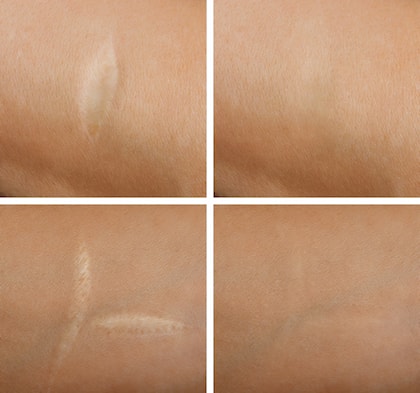The reaction to having a scar on the skin varies per person. Some have an initial reaction of shock followed by feelings of anxiety of what the scar will look like after it completely forms. Others have feelings about the scar that are related to the event such as anger and shame.
No matter what the reaction is from a person when it comes to a scar, patients want to find a way to lessen or eliminate the appearance of the scar. Let’s take a look at different types of scars and the best methods to treat them.

Types of Scars and Their Treatment
- Raised Scars – Raised scars, including keloid and hypertrophic scars, occur due to an overgrowth of tissue that is dense and fibrous after an injury to the skin heals. There are some differences between these two types of raised scars. In general, hypertrophic scars are the same size as the wound that caused them. The scar could be the result of injuries from a burn or piercing or cut. On the other hand, keloid scars extend beyond the limits of the injury and they are often found in patients with pigmented skin. They do not usually diminish or go away by themselves and often require some form of treatment to soften or flatten the impacted areas. Some of the most popular treatment options for raised scars include surgical removal, creams, medicinal corticosteroid injections, freezing, laser therapy, gels or dressings that put pressure on the scar.
- Superficial Scars – A superficial scar is a red blotch that appears on the skin post-acne. Retinol is a good scar treatment solution for most skin types and it seems to work very well for those who suffer from this type of scarring. There are some patients that have been advised to avoid retinol because they are pregnant or they have skin that is sensitive on a regular basis. These patients can try a product with bakuchiol which is a natural alternative for exfoliating and it also increases the rate of cell turnover.
- Ice-Pick Scars – As their name suggests, ice-pick scars are small, deep holes that are caused by acne. Their overall look makes it appear that the person with these scars has been punctured by an ice pick. Unfortunately, there is no “cure-all product” that patients can buy over the counter. Many doctors recommend against the use of lotions, creams or oils to treat ice-pick scars as they are often ineffective against these types of scars. Since many skin care products are not effective in the treatment of ice-pick scars, patients suffering from them are better off seeking out the expert help of a board-certified dermatologist.
- Boxcar Scars – Boxcar scars are a broad depression that has sharply-defined edges that create the look of a “crater” in the skin. Some of the most popular treatments for this type of scar include dermal rolling and using a laser to stimulate collagen in order to smooth the acne depression by plumping the skin. It should be noted that most doctors recommend having any boxcar scar treatment performed as soon as possible since it can be more challenging to treat older scars.
- Rolling Scars – This type of scar is quite similar to boxcar scars in that they have a deep “crater-like” appearance. The main difference is that rolling scars have more of a sloped edge. Rolling scars can generally be treated the same way as boxcar scars but, if the scars are extreme in nature, cosmetic treatments might need to be considered by the cosmetic doctor. One option is fillers that can be injected into the treated area in order to stimulate collagen to treat the scarring. In addition, there is a resurfacing technique that is performed by the Venus Viva system that uses NanoFractional radiofrequency to heat the tissue and encourage collagen production. If the scars are deeper in the skin, a laser treatment like the Erbium:YAG (Er:YAG) laser can be used to physically remove layers of skin. Once the layers of skin are removed, a wound forms around the removed layers which force the skin to regenerate at a more optimum level.
Post-Inflammatory Hyperpigmentation of Scars
The condition known as post-inflammatory hyperpigmentation is a common side effect of acne and it can leave dark marks in patches or dots on the skin. The treatment options for this side effect can include products that are used topically to fade the dark patches such as hydroquinone that is prescribed by a board-certified doctor. Patients should also search for ingredients that suppress excess melanin pigment such as vitamin C, licorice extract, retinol, niacinamide and bakuchiol. In addition, the use of a broad-spectrum sunscreen on a daily basis helps to prevent the condition from getting any worse.
Don’t Pick at the Scars during Scar Treatment
When it comes to treating scars, it is important not to pick or squeeze a scar because the pressure can increase the inflammation and infection deep into the skin. This warning is also the same when it comes to picking at scabs because this can increase the chances of scarring. It takes time and patience to achieve the best results and patients need to relax and give the scar treatments listed above time to properly treat the scars.
